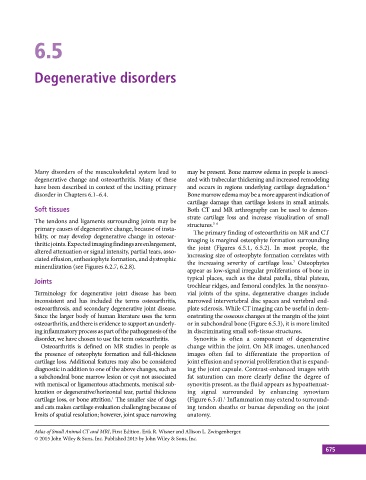Page 685 - Atlas of Small Animal CT and MRI
P. 685
6.5
Degenerative disorders
Many disorders of the musculoskeletal system lead to may be present. Bone marrow edema in people is associ-
degenerative change and osteoarthritis. Many of these ated with trabecular thickening and increased remodeling
have been described in context of the inciting primary and occurs in regions underlying cartilage degradation.
2
disorder in Chapters 6.1–6.4. Bone marrow edema may be a more apparent indication of
cartilage damage than cartilage lesions in small animals.
Soft tissues Both CT and MR arthrography can be used to demon-
strate cartilage loss and increase visualization of small
The tendons and ligaments surrounding joints may be structures. 3–6
primary causes of degenerative change, because of insta- The primary finding of osteoarthritis on MR and CT
bility, or may develop degenerative change in osteoar- imaging is marginal osteophyte formation surrounding
thritic joints. Expected imaging findings are enlargement, the joint (Figures 6.5.1, 6.5.2). In most people, the
altered attenuation or signal intensity, partial tears, asso- increasing size of osteophyte formation correlates with
ciated effusion, enthesiophyte formation, and dystrophic the increasing severity of cartilage loss. Osteophytes
7
mineralization (see Figures 6.2.7, 6.2.8).
appear as low‐signal irregular proliferations of bone in
Joints typical places, such as the distal patella, tibial plateau,
trochlear ridges, and femoral condyles. In the nonsyno-
Terminology for degenerative joint disease has been vial joints of the spine, degenerative changes include
inconsistent and has included the terms osteoarthritis, narrowed intervertebral disc spaces and vertebral end-
osteoarthrosis, and secondary degenerative joint disease. plate sclerosis. While CT imaging can be useful in dem-
Since the larger body of human literature uses the term onstrating the osseous changes at the margin of the joint
osteoarthritis, and there is evidence to support an underly- or in subchondral bone (Figure 6.5.3), it is more limited
ing inflammatory process as part of the pathogenesis of the in discriminating small soft‐tissue structures.
disorder, we have chosen to use the term osteoarthritis. Synovitis is often a component of degenerative
Osteoarthritis is defined on MR studies in people as change within the joint. On MR images, unenhanced
the presence of osteophyte formation and full‐thickness images often fail to differentiate the proportion of
cartilage loss. Additional features may also be considered joint effusion and synovial proliferation that is expand-
diagnostic in addition to one of the above changes, such as ing the joint capsule. Contrast‐enhanced images with
a subchondral bone marrow lesion or cyst not associated fat saturation can more clearly define the degree of
with meniscal or ligamentous attachments, meniscal sub- synovitis present, as the fluid appears as hypoattenuat-
luxation or degenerative/horizontal tear, partial thickness ing signal surrounded by enhancing synovium
cartilage loss, or bone attrition. The smaller size of dogs (Figure 6.5.4). Inflammation may extend to surround-
1
1
and cats makes cartilage evaluation challenging because of ing tendon sheaths or bursae depending on the joint
limits of spatial resolution; however, joint space narrowing anatomy.
Atlas of Small Animal CT and MRI, First Edition. Erik R. Wisner and Allison L. Zwingenberger.
© 2015 John Wiley & Sons, Inc. Published 2015 by John Wiley & Sons, Inc.
675

